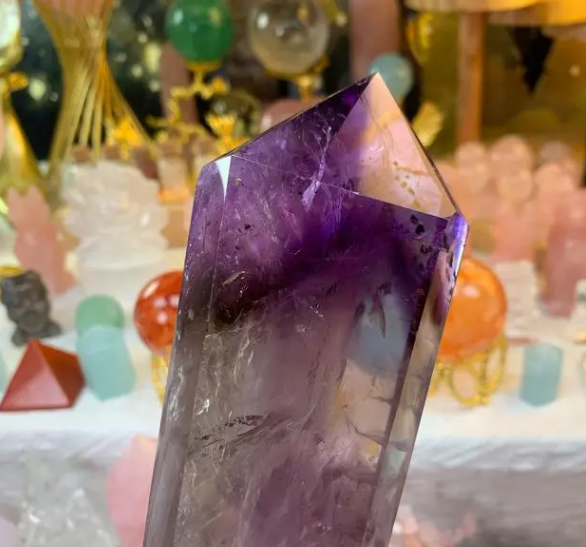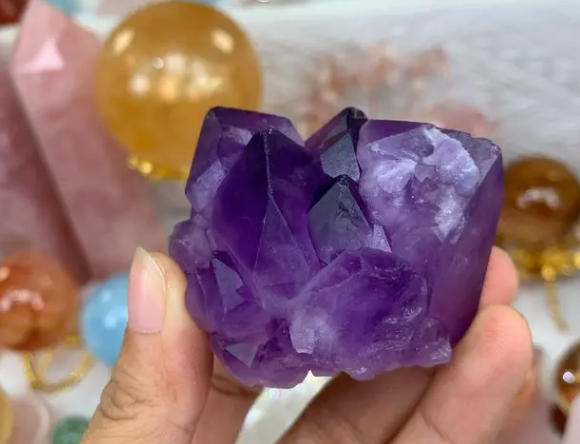Get to know Purple Crystal
Amethyst, derived from the Greek term “Amethystos,” owes its name to an early Greek myth that associates this gemstone with the wine god Bacchus due to its wine-like color. According to the legend, the moon goddess transformed a maiden into a crystal statue to protect her from a tiger. Later, Bacchus, upon discovering the petrified maiden, deeply regretted his impulse and shed tears of remorse that resembled wine. These tears dripped onto the statue, instantly transforming it into a purple hue, thus giving birth to the name Amethyst.
Amethyst is a gemstone-grade quartz mineral, with its unique purple color stemming from trace amounts of iron, manganese, and other minerals. As a member of the quartz crystal family, amethyst possesses a hexagonal crystal structure, which is often believed to assist in manifestation.
Amethyst boasts a variety of colors, including light purple, purple-red, deep red, bright red, deep purple, and blue-purple. Among them, deep purple-red and bright red are considered the best, while overly light purple is relatively common. Let’s delve into the differences among Bolivian amethyst, Brazilian amethyst, and Uruguayan amethyst:
Bolivian amethyst, also known as the “Sky Mirror,” features a lighter color compared to other origins. Its crystals are more transparent, appearing as a sort of taro-like purple to the naked eye, making it perfect for those who prefer pastel shades.
Brazilian amethyst displays a uniform distribution of colors, with visible color bands. Its quality is primarily determined by the depth of color, crystal transparency, and internal inclusions. In brief, Brazilian amethyst is characterized by its high transparency, distinct crystals, and color bands.
Uruguayan amethyst boasts a rich, dark purple color, reminiscent of black currants. However, it’s worth noting that darker is not always better; amethyst that is too dark, approaching black, is not ideal. Instead, Uruguayan amethyst with clearer crystals is preferred.
Amethyst originates from various locations, including Brazil, Uruguay, Bolivia, Argentina, Zambia, and Namibia. South America, in particular, produces large, high-clarity amethyst crystals.
Amethyst holds multiple meanings and purposes in culture and beliefs. It stimulates the brow chakra, enhancing brain activity and facilitating intellectual development, concentration, memory enhancement, and cognitive function. For individuals who engage in prolonged mental activities, such as students and office workers, wearing natural amethyst is an indispensable gemstone tool.
Furthermore, amethyst symbolizes a fulfilling love life. Westerners view it as the guardian stone of love, believing it instills honesty, courage, and deepens the bond between couples. Thus, amethyst is often exchanged as a gift between lovers and spouses.
Amethyst also signifies academic and career success, as well as personal luck enhancement. In terms of wealth, placing an amethyst geode or wearing an amethyst bracelet in the office’s wealth corner can attract financial prosperity and popularity. In terms of relationships, amethyst strengthens interpersonal connections, making it easier to receive help from mentors, gain recognition from superiors in the workplace, expand business networks for entrepreneurs, and overcome obstacles related to interpersonal relationships.



Rose Quartz Healing for Women Anxiety Crystal Bracelet
$29.00Original price was: $29.00.$23.00Current price is: $23.00.